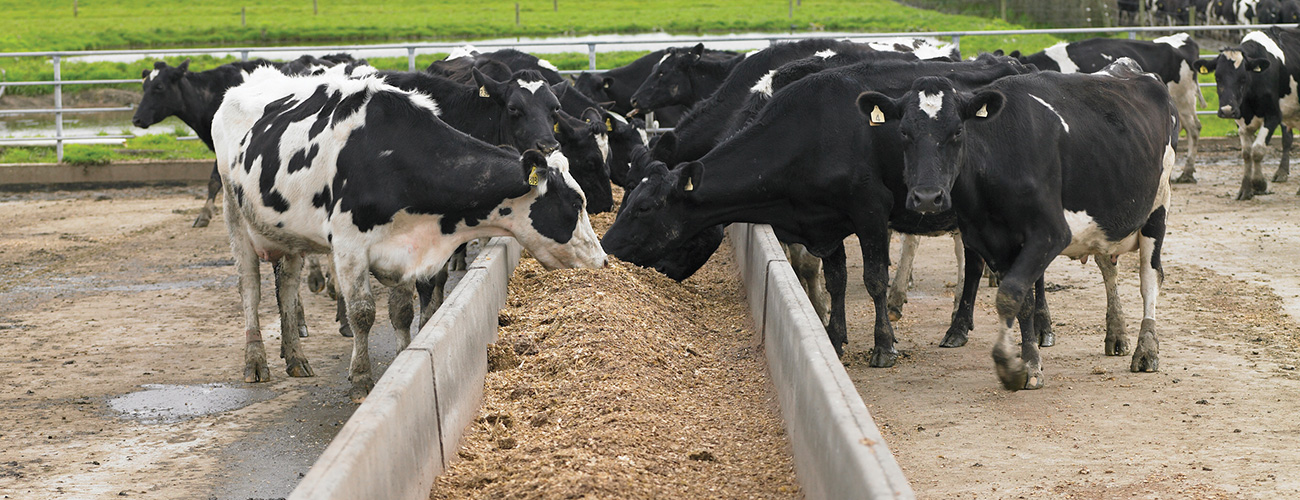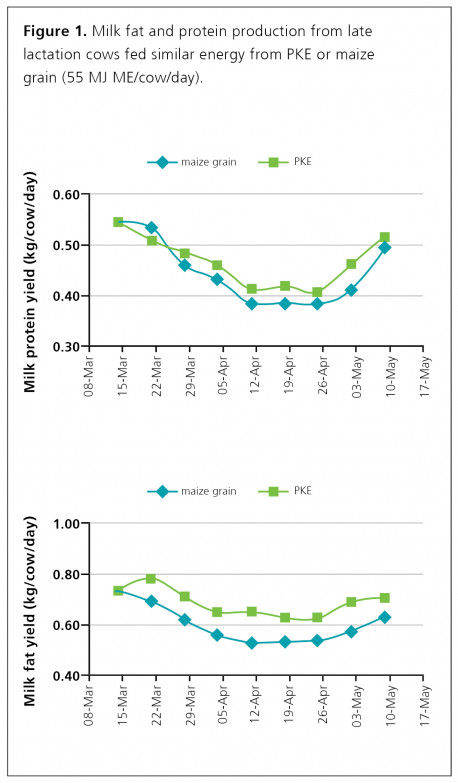
Supplement research surprises
Author: Jane Kay, DairyNZ
When fed the same amount of metabolisable energy (ME) in late lactation from either palm kernel extract (PKE) or maize grain, cows gained the same amount of body condition. However, there was an unexplained increase in milksolids yield in cows fed PKE. The research was conducted by DairyNZ senior scientists Jane Kay and Claire Phyn, post-doctoral scientist Talia Grala, and principal scientist John Roche.
Key points
- Late lactation cows were fed 55 MJ metabolisable energy a day from palm kernel extract (PKE; a high-fibre supplementary feed) or maize grain (a high-starch feed).
- Cows fed PKE produced more milksolids than those fed maize grain.
- Body condition gain did not differ between the two groups.
- The reason for the milksolids difference is unknown; however, possible reasons include:
- there may be less substitution of pasture in cows fed PKE compared with maize grain,
- the ME content of PKE may be greater than currently predicted, based on laboratory analyses.
 A question often asked is "What is the impact of feeding different supplements on cow performance during late lactation?"
A question often asked is "What is the impact of feeding different supplements on cow performance during late lactation?"
Based on previous research conducted in early lactation1 and during the dry period2, it was believed that feeding a starch-based supplement, such as maize or barley grain, would increase milk volume and milk protein yields, whereas a high fibre supplement, such as PKE, would increase milk fat percentage and body condition score (BCS).
When carbohydrates (e.g. fibre, sugar or starch) are fed, they are fermented in the rumen by micro-organisms and the by-products (which include volatile fatty acids) provide energy for the dairy cow. There are three main volatile fatty acids produced in the rumen: acetic, propionic and butyric acids, and the relative proportion of these are influenced by the types of carbohydrate that are fed.
When a high sugar or starch supplement is fed, the production of propionic acid increases. This is a precursor for glucose synthesis, which is then used to produce lactose in the mammary gland, increasing milk volume. In addition, the increased glucose synthesis is associated with a greater uptake of amino acids by the mammary gland, and this increases milk protein synthesis.
In contrast, a high fibre supplement, such as PKE or pasture silage, increases the proportion of acetic acid produced in the rumen, which is the building block for milk fat and body fat synthesis.
Therefore, people have concluded that feeding a high starch supplement in late lactation would promote milk protein and milk yield, whereas a high fibre supplement would increase BCS gain and milk fat yield.
As there has been limited research on the effect of these supplements in late lactation, a DairyNZ experiment was conducted in March-May 2014 to quantify the milk production and BCS response to dietary energy provided as either a fibre- (PKE) or starch-based (maize grain) supplement.
Cross-bred cows, grazing pasture, were allocated to one of two treatment groups; one group was supplemented with maize grain (high starch), and the other with PKE (high fibre and fat) for eight weeks until dry off.
To ensure that the predicted ME supplied from the two feed sources was equal (approximately 55 ME; MJ), cows were fed either 4kg DM/d maize grain (13.5 MJ ME/kg DM) or 5kg DM/d PKE (11.0 MJ ME/kg DM). The daily supplement allowance was split evenly between the morning and afternoon milkings.
Uncovering the unexpected
BCS gain did not differ between cows supplemented with PKE or maize grain. On average, all cows gained approximately 0.25 BCS over the eight week period.
In addition, there was no difference in milk yield between cows fed PKE or maize grain; however, milk protein and milk fat concentrations were greater in milk from cows fed PKE, resulting in 0.1kg/cow/d more milk fat and 0.02kg/cow/d more milk protein (Figure 1). Over the eight week period, this amounted to 6.7kg more milksolids produced from cows fed PKE compared with cows fed the same estimated amount of ME from maize grain. This result was not anticipated.
So what caused the difference?
Because the ME of the supplementary feeds was predicted to be the same for both treatments, DairyNZ researchers did not expect to see a difference in total milksolids production. This hypothesis was based on previous research: when starch has replaced fibre in the diet, milk protein yield increased while milk fat yield decreased, resulting in no net change in total milksolids1. However, in this experiment, feeding a fibre-based supplement (PKE) increased both milk fat and milk protein yields, resulting in an increase in total milksolids production. Possible explanations for why this occurred are:
Did cows fed PKE eat more pasture?
Feeding cows maize grain may have resulted in greater pasture substitution compared with feeding PKE due to the increased satiety signals that are released when starch-based supplements are fed. The satiety signals tell the cow that she is not hungry and does not need to spend any more energy grazing. If there was increased substitution when maize grain was fed, this would result in a lower pasture intake and, therefore, a lower total energy intake compared with cows that were supplemented with PKE2.
However, the difference in milksolids production between cows fed PKE and maize grain was equivalent to approximately 12 MJ ME or 1kg DM pasture/cow/d. This would be less than 100kg DM/ha difference in post-grazing pasture residuals and would be difficult to detect. Unsurprisingly, therefore, the pre and post-grazing measurements taken during the study did not indicate any differences in pasture intake between the different supplements.
Are our estimates of the ME of PKE accurate?
Currently, there is no equation available to calculate the ME of PKE accurately. Therefore, it is possible that current laboratory predictions are incorrect. Further work is required to determine the true ME of PKE, as the milk production responses in this trial, as well as the efficiency of BCS gain in dry cows reported previously3, are greater than current ME estimates would indicate.
Was the maize grain diet deficient in protein?
Maize grain is lower in crude protein (CP) than PKE (approximately 9% vs. 18% CP); therefore, total dietary CP content was lower for cows fed maize grain than PKE (15% vs 18% CP). However, the total CP content of both diets was greater than the typical dietary recommendations for late lactation cows of 14% CP. A protein deficiency is therefore, unlikely to have contributed to the difference in total milksolids production between the two treatments.
Conclusion and implications
Further research is required to confirm the underlying reason(s) for the unexpected response. DairyNZ’s recommendations remain that if supplements are required to fill a feed deficit during late lactation, they should be purchased on a cents/MJ ME basis.
For more information contact DairyNZ on 0800 4 DairyNZ (0800 4 324 7969).

